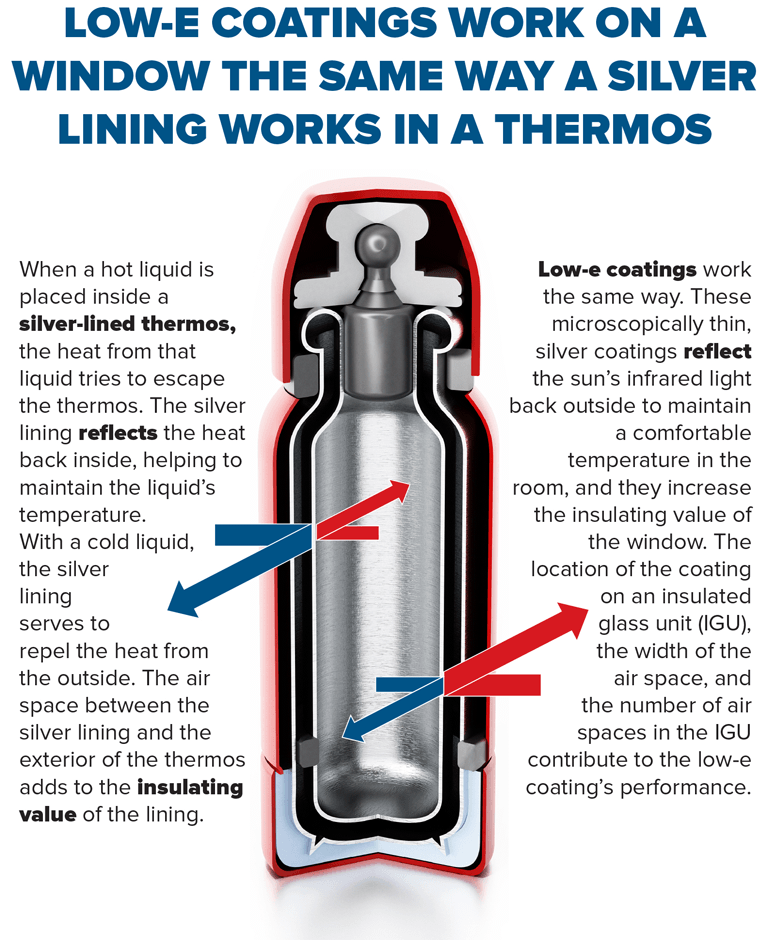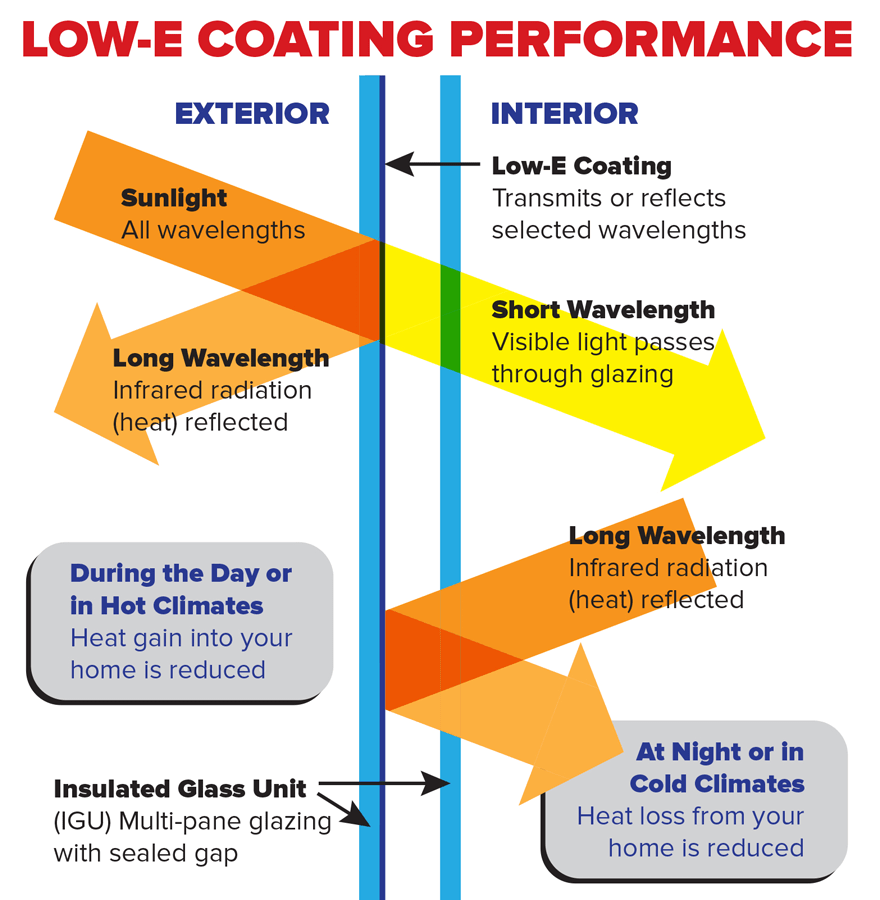Heat loss through windows and doors accounts for approximately 30% of the heat lost in the entire house. Low-E glass is a modern invention that can help reduce heat loss in the winter and prevent heat entry in the summer (1).
For homeowners on the search for energy-efficient windows and smart solutions to energy loss problems, low-E glass is a must. By changing the way that window glass transfers heat, low-E coatings can help keep homes comfortable while reducing energy costs throughout the year.
Here’s what every homeowner should know and what we will cover:
- What Is Low-E Glass?
- How Does It Work?
- What Are the Benefits?
- What Is the Science Behind It?
- Does It Perform in Different Season/Climate?
- Does Low-E Glass Impact How Much Sunlight Comes into Your Home?
- Can Low-E Glass Help Lower Energy Costs?
- How Can I Tell If I Have Low-E Windows?
- Does Low-E Add to the Cost of Replacement Windows?
What Is Low-E Glass?
Low-E stands for "low emissivity". Low-E windows contain glass that has been coated in invisible layers of metallic oxide. This coating allows natural light to enter the home while deflecting UV rays and infrared light back out into the environment. Why is this important?
UV rays are invisible rays of light emitted by the sun. UV rays are responsible for fading upholstery, burning skin and, over the course of many years, damaging building materials. Infrared light is heat that warms your home during the winter. By deflecting both types of light back out into the environment, low-E coatings help keep your home warm in winter and cool in summer (2).
How Does It Work?
In a way, low-E coatings sound almost too good to be true. How can glass enable light to enter or exit the home, while preventing heat loss in the winter and heat entry in the summer?
Low-E coatings are not visible to the naked eye. However, they are still reflective, just like the silver coating on the inside of a thermos. This reduces the emissivity of the glass and prevents certain types of light from entering or exiting the home. Low-E coatings are selectively reflective, and only allow light of a certain wavelength and frequency to pass through glass (3).

What Are the Benefits?
Low-E coatings are beneficial to homeowners in a variety of ways:
- Dramatic reduction in heat loss. Stop heat transfer and reduce heat loss in the home by as much as 50% (4).
- Cost Savings. Homeowners will see reduction in energy bills by using low-E glass.
- Invisible. Low-E glass is not visible to people.
- Durable. Low-E coatings cannot be wiped away, scratched off or damaged because the coating is applied to the inside of the glass.
- Protection of furniture, flooring material and upholstery. UV rays are prevented from penetrating and damaging furniture.
For many homeowners, these benefits can result in significant cost savings over time. In some cases, installation of new energy efficient windows may even improve property values. Home buyers like to purchase homes that have energy-efficient, money-saving features like low-E windows (5).
What Is the Science Behind It?
Light takes many forms, but visible light occupies only a fraction of the spectrum. Other parts of the light spectrum include short-wave solar energy (UV rays) and long-wave infrared (heat).
Low-E glass has a coating that reflects short and long-wave infrared rays. The only light that passes through low-E coatings is visible light. Low emissivity glass prevents heat transfer and ensures that visible light is able to pass through the glass in both directions.

Low-E coatings come in two types: hard coat and soft coat. Hard coat is made by pouring melted tin on the glass, while soft coat low-e glass is made with silver, tin or zinc that is applied to the glass in a vacuum. Soft coat low-E coatings have a higher R-value, so they provide better insulation than hard coat (6).
Does It Perform in Different Season/Climate?
During the summer, this reflective coat sends heat back into the atmosphere instead of allowing it to enter into the home via the glass. During the winter, the reflective coat sends heat back into the home to keep the interior of the house comfortable. This innovative coating, along with the space between the panes of glass, serves as an excellent insulator for residential homes (7).
Does Low-E Glass Impact How Much Sunlight Comes into Your Home?
Depending on how many coatings are applied to the window, low-E coatings can cause a window to look somewhat tinted. This should not affect the clarity of the view through the window and is usually negligible. The sun's UV rays are impacted, but this cannot be seen by humans and is a desirable outcome anyway. Consult the NFRC sticker on your window to see the visible transmittance, or the amount of visible light coming through the window.
Can Low-E Glass Help Lower Energy Costs?
Low-E glass can help reduce energy costs by reducing the amount of heat that leaves and enters the home on a summer or winter day. During the summer, low-E glass shuts hot air out of the home. During the winter, low-E glass keeps warm air in the home to reduce the burden on the furnace.
How Can I Tell If I Have Low-E Windows?
Because low-E windows are considered desirable, many home sellers will mention if their home has low-E windows when they list their home on the market. Home buyers who are not told whether their new home has this type of windows at the time of purchase can find out by performing the following experiment:
Hold a flame up to the window so you can see the flame's reflection in the glass. In a double pane window, you'll be able to see four reflections. In a normal glass window, all four reflections will be the same color. In a low-E window, one of the reflections will appear to be a different color than the others (8).
Does Low-E Add to the Cost of Replacement Windows?
Because more technology and labor go into low-E windows, they do tend to add an additional cost over standard windows without low-e coating. However, low-E windows can produce significant savings over time. Energy loss from heat conduction can be reduced by as much as 50% with low-E coatings. In other words, homeowners who install low-E windows at their property can make back the extra money they spend.
In addition to reducing energy costs for the entire home, these windows also reduce costs in maintaining and replacing furnishings and flooring material in the home. Low-E windows also reduce the burden on the home's HVAC system. By making it easier to heat and cool the house, low-E windows can actually extend the service life of a home's air conditioner and furnace.
Ultimately, installation of low-E windows can result in cost savings in a variety of ways. These cost savings should be taken into consideration when trying to decide whether this type of window is worth the expense (9, 10).
